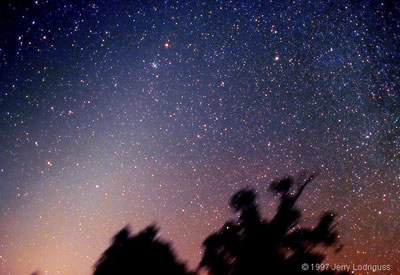Zodiacal Light

Credit: Jerry Lodriguss
Zodiacal light results from the scattering of sunlight off small (1 – 300 micron) interplanetary dust particles lying in the plane of the ecliptic. This dust originates through the sublimation of cometary nuclei and collisions between asteroids, and forms a band of dust that completely circles the Sun and stretches out to the orbit of Jupiter.
At a dark site on a moonless night, it may be possible to see a faint (comparable in brightness to the Milky Way), triangular-shaped glow that stretches along the ecliptic from the Sun. This is the zodiacal light, which can be observed from low latitudes all year round. From mid to high latitudes, it is best observed about 90 minutes after sunset during the spring, or 90 minutes before sunrise during the autumn, when the ecliptic is steeply inclined to the horizon. Under good conditions it can be seen to extend up to 90 degrees along the ecliptic.
Study Astronomy Online at Swinburne University
All material is © Swinburne University of Technology except where indicated.

